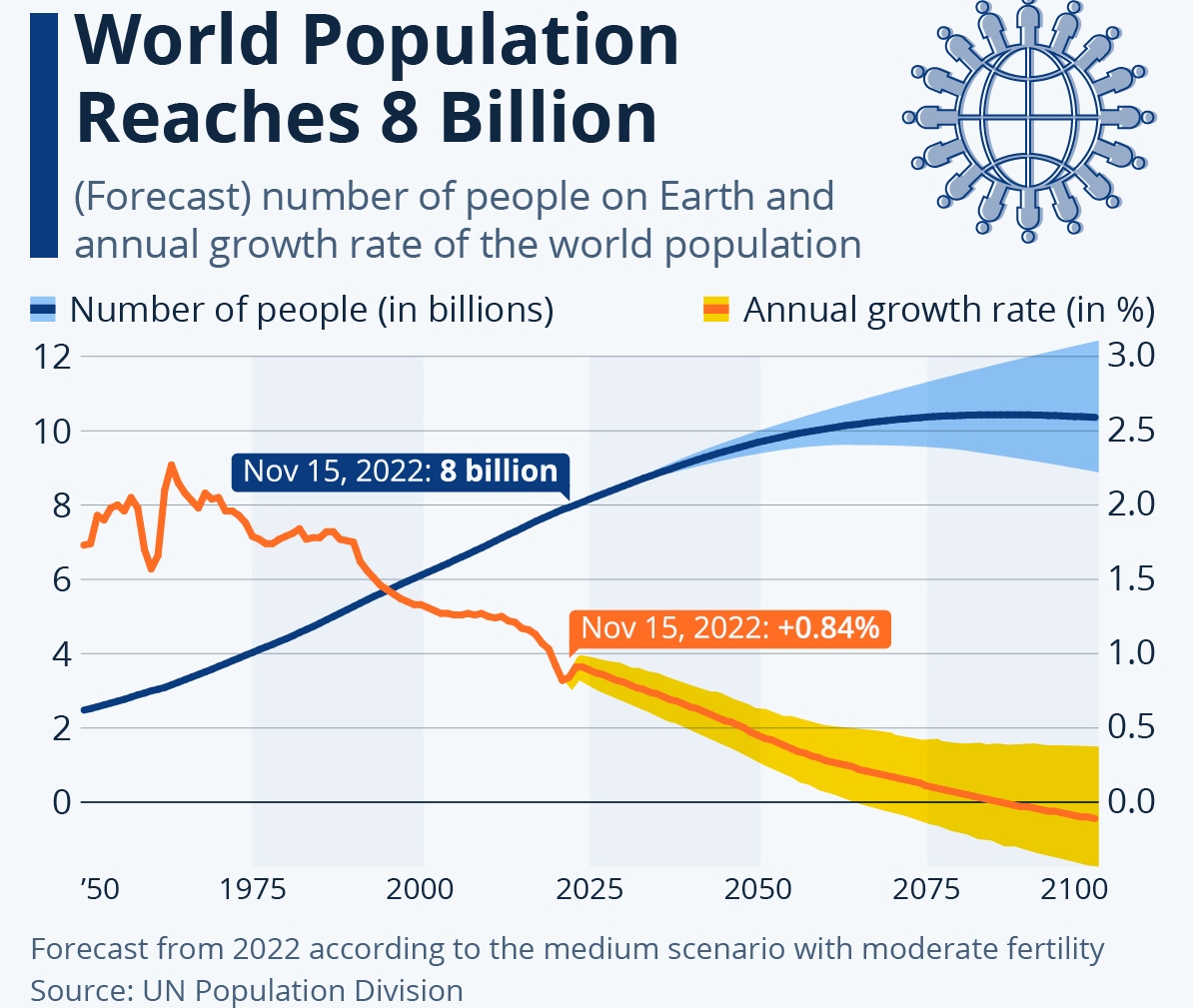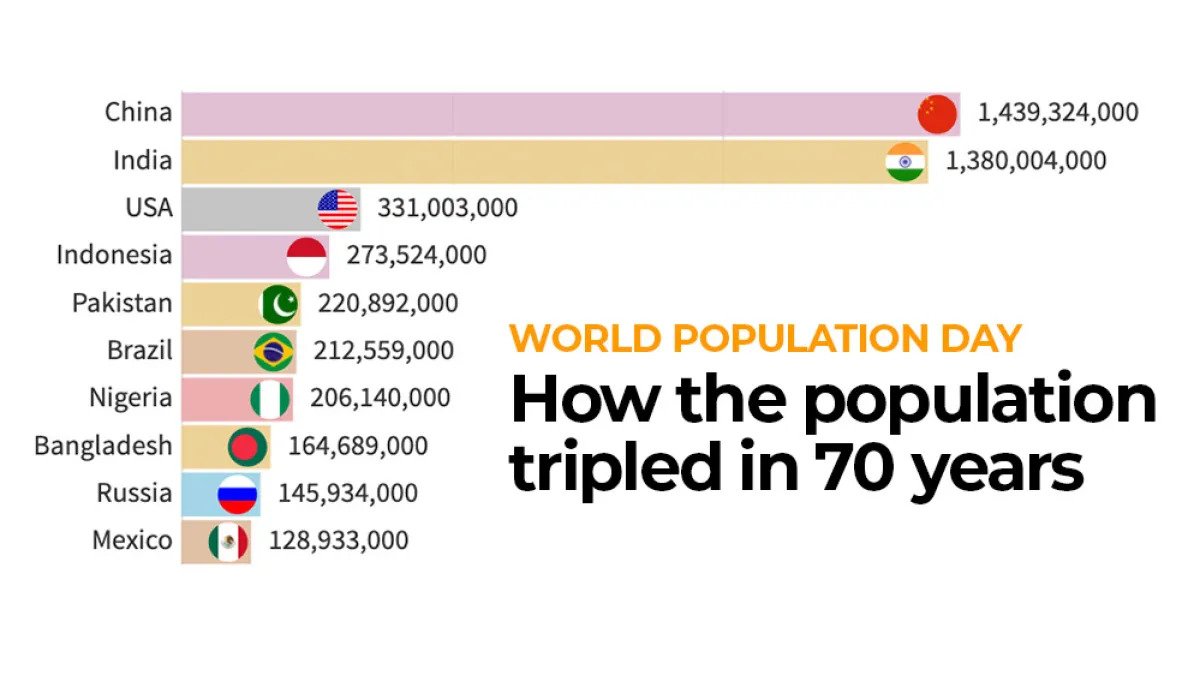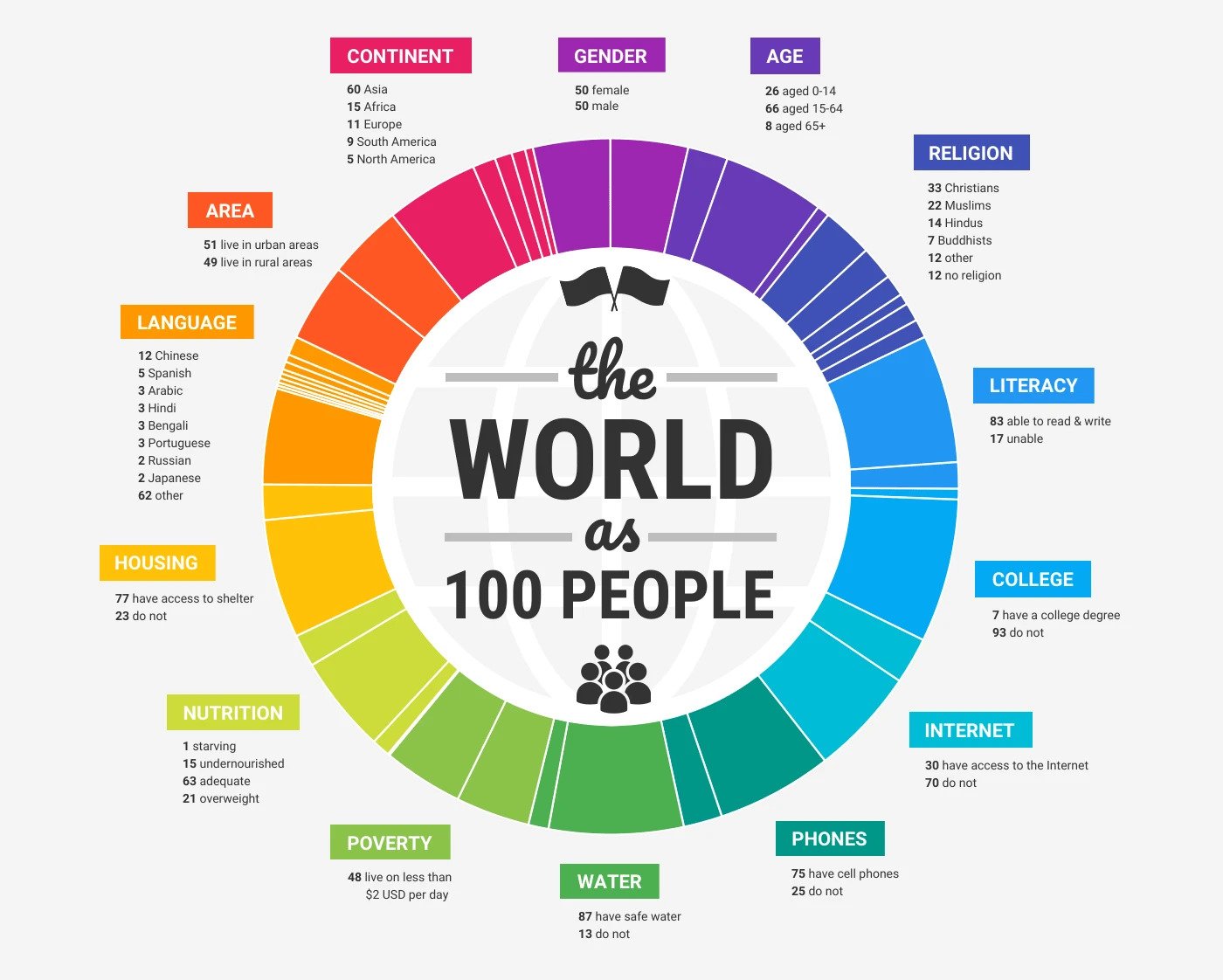How Many People Are In The World? Population Puzzles
The question of how many people are in the world is not merely a statistical query; it is a gateway to understanding the complexities of our shared human experience.
Author:Karan EmeryReviewer:Daniel JamesOct 08, 202351.5K Shares937.5K Views

How many people are in the world?This is the question that often sparks curiosity and contemplation. This seemingly simple inquiry opens the door to a vast realm of interconnected complexities that shape our societies, influence global trends, and define the challenges and opportunities of our time.
The global population, which stands at approximately 8 billion, is more than just a number; it is a dynamic entity that reflects the evolution of our species, the impact on our planet, and the narratives of countless lives.
In this exploration, we delve into the intricacies of how many people are in the world, uncovering its many facets, from historical shifts to contemporary challenges and opportunities.
A Growing Global Economy
Since the beginning of history, population increase has always been accompanied with economic growth, typically with per capita growth as well.
In the 46 years from 1971 to 2017, when the world's population doubled, the global economy more than quadrupled from $19.9 to $80.1 trillion (in constant prices).
The amount of natural resources that humans consumed on Earth tripled between 1970 and 2010 (or roughly the same period).
Population Growth Trends
The journey of human population on Earth has witnessed remarkable shifts over the centuries.
From small, scattered communities, we have burgeoned into a global society interconnected through technology, trade, and shared challenges. Examining population growth trends is essential to understanding our past and projecting into the future.
Historically, human population remained relatively stable for centuries, experiencing gradual growth. However, the Industrial Revolution in the 18th century ushered in a period of unprecedented expansion.
Technological advancements, improved healthcare, and increased agricultural productivity contributed to a surge in population growth.
The mid-20th century saw a significant spike, often referred to as the population explosion. Factors such as medical breakthroughs, vaccinations, and improved sanitation led to a decrease in mortality rates, resulting in a rapid increase in population size.
In recent decades, there has been a gradual slowdown in the rate of population growth. This can be attributed to factors like family planning initiatives, educational opportunities for women, and a shift towards urbanization.
Understanding these trends is crucial for policymakers as they navigate the challenges and opportunities presented by a growing or stabilizing population.
Future - A Significantly Larger Global Economy
The UN predicted in 2000 that the world economy will expand between 10 to a staggering 26 times during the 21st century.
The world economy is predicted to grow by two times between 2016 and 2050, reaching over $150 trillion, according to a PwC research from 2017.
No matter what the precise rate of economic development will be, the resources of the planet will be under tremendous strain. And with a 175 percent overuse, we already are...
Milestones In World Population
In 2058, the world's population is expected to surpass 10 billion, according to the UN.
- 2037 - 9 billion
- As of today - 8 billion
Eight Billion By 2022
The United Nations estimates that on November 15, 2022, there will be 8 billion people on the planet. In October 2023, according to the International Database (IDB) of the U.S. Census Bureau, there will be 8 billion people on the planet.
2010 - 7 Billion
The world population reportedly hit 7 billion people in late 2010 (instead of the previously predicted date of October 31, 2011), according to the United Nations' most recent adjustment (published in 2022).
According to a different estimate published by the U.S. Census Bureau, the 7 billion mark was attained on March 12, 2012.
2006 - 6 Billion
The Day of 6 Billion was observed on October 12, 1999, but the most recent United Nations revision (published in 2022) indicates that the 6 billion mark was really attained toward the end of 1998.
Instead, the six billion mark was reached on July 22, 1999, at approximately 3:49 AM GMT, according to the U.S. Census Bureau. However, the U.S. Census Bureau predicts that because the already speculative estimates are updated frequently, the precise moment that the 6 billion mark was reached will change.
Prior Milestones
- 5 Billion - 1987
- 4 Billion -1974
- 3 Billion -1960
- 2 Billion -1930
- 1 Billion -1804
What Population Estimates Are Available For Prehistoric And Historical Periods?
The length of time that humans are believed to have been on Earth, the average population size at various times, and the number of births per 1,000 people throughout each of those times all play a role in any estimate of the total number of people who have ever lived.However, the estimate is independent of any one period's mortality toll.
It is difficult to pinpoint the exact beginning of humanity. According to some estimates, the earliest hominins emerged as early as 7 million B.C.E.
Approximately 2 million to 1.5 million years ago, the earliest species of the genus Homo first emerged. According to current research, modern Homo sapiens first appeared around 190,000 B.C.E.
Though the precise site has long been disputed, modern Homo sapiens are believed to have originated in Africa. Over the course of the first two-thirds of human history, many groups are believed to have coexisted in various parts of Africa.
In the year 8000 B.C.E., there were about 5 million people on the planet. Only 0.05% of the population increased annually during the 8,000-year span, from an estimated 5 million people in 8000 B.C.E. to 300 million in 1 C.E.
It's challenging to estimate the average global population at this time. Human populations in various areas most likely increased or decreased in reaction to factors such as food supply, animal herd variability, peaceful or hostile times, and changing weather and climatic circumstances.
Whatever the case, life was brief. For the most of human history, the average life expectancy at birth was probably only around ten years. For the species to thrive under these circumstances, there would need to be roughly 80 live births per 1,000 people.
In order to put it into perspective, a high birth rate nowadays is defined as between 35 and 45 live births per 1,000 people, and it is only seen in a small number of sub-Saharan African nations.
Because of these low life expectancies, it has been difficult for the human population to grow. One estimate places the population of the Roman Empire in 14 CE, which stretched from Spain to Asia Minor, at 45 million.
However, other historians raised the estimate by two times, illustrating how shaky population projections for early historical periods may be.
The estimated 300 million people on the planet in 1 C.E. had increased to approximately 500 million by 1650, which is not a significant rise.
In fact, the average annual rate of increase throughout this time was lower than the rate predicted for the period from 8000 BCE to 1 CE. The Black Death was one factor in the relatively slow expansion.
This terrifying illness may have started in western Asia around 542 C.E. and spread from there, not just in Europe in the 14th century.
According to experts, the epidemic killed 100 million people in the sixth century, destroying half of the Byzantine Empire. The difficulty of determining the total number of individuals who have ever lived is substantially exacerbated by such enormous changes in population size over such extended periods.
However, by 1800, the world's population had surpassed the 1 billion mark and has since continued to rise, reaching its present 8 billion people.
Advances in diet, medicine, and public health have reduced mortality rates and allowed more people to live well into their reproductive years, which has contributed significantly to this growth.
Percentage By Weight Of The Variety Of Life On Earth
- Fish: 0.7 %
- Humans: 0.01 %
- Wild mammals: 0.001 %
- Plants: 81.8 %
- Bacteria: 12.7 %
- Fungi: 2.2 %
- Animals: 0.36 %
Plants make up the vast majority of life on our planet, accounting for roughly 82 percent of it. But even if we exclude plants, human beings only account for 6% of all life on Earth.
Percentage Of Weight Of Different Types Of Life On Earth - Excluding Plants
- Fish: 0.1 %
- Humans: 0.06 %
- Wild mammals: 0.007 %
- Bacteria: 70 %
- Fungi: 12 %
- Animals: 2 %
Humans make up just approximately 2-3 percent of all life, even if we exclude all other kinds of life such as plants, bacteria, fungi, and others and only include animals.
Weight-based Selection Of Life On Earth - Only Animals
- Marine arthropods (lobsters, crabs, shrimp etc.) 38 %
- Fish 27 %
- Terrestrial arthropods (spiders, scorpions etc.) 7.7 %
- Molluscs (snails, squids etc.) 7.7 %
- Annelids (ringed worms) 7,7 %
- Nematodes (roundworms) 7.7 %
- Cnidarians (jellyfish) 3.8 %
- Livestock (cattle, pigs, sheep etc.) 3.8 %
- Wild mammals 2.7 %
- Humans 2.3 %
- Wild birds 0.08 %
The Global Population - Challenges And Opportunities Of A Growing Global Population
As we contemplate the sheer magnitude of the world's population, surpassing 8.1 billion, it becomes crucial to explore the myriad challenges and opportunities that arise from this demographic landscape. From resource sustainability to harnessing the potential of a diverse global workforce, understanding the dynamics at play is essential for charting a course toward a balanced and thriving future.
Challenges
- Resource Scarcity - The exponential growth in the global population poses significant challenges regarding resource management. Basic necessities such as water, food, and energy face increasing demands, leading to concerns about sustainability. Striking a balance between meeting the needs of a growing population and preserving the environment is a pressing challenge for policymakers and communities worldwide.
- Environmental Impact - The environmental footprint of 7.9 billion people is undeniable. Climate change, deforestation, and loss of biodiversity are direct consequences of human activities. Addressing these challenges requires a concerted global effort to adopt sustainable practices, reduce emissions, and transition towards eco-friendly technologies.
- Infrastructure Strain - Rapid urbanization, fueled by population growth, places immense strain on infrastructure. From transportation systems to healthcare facilities, cities must adapt to accommodate larger populations. Smart urban planning and investments in resilient infrastructure are imperative to ensure the well-being of urban communities.
- Social Inequality - Disparities in wealth, education, and healthcare often widen as populations grow. Tackling social inequality requires not only addressing immediate challenges but also implementing long-term strategies that promote inclusive economic growth and equitable access to opportunities.
- Healthcare Demands - The sheer number of individuals in need of healthcare services presents a challenge to healthcare systems globally. Providing adequate medical care, especially in the face of pandemics and emerging health threats, requires proactive measures, robust healthcare infrastructure, and international collaboration.
Opportunities
- Diverse Workforce - A large and diverse global population brings with it a rich tapestry of skills, talents, and perspectives. Harnessing the potential of this diverse workforce can drive innovation, creativity, and economic growth. Inclusive employment practices and educational opportunities empower individuals to contribute meaningfully to the global community.
- Technological Advancements - The challenges posed by a growing population are met with innovative solutions. Technological advancements in agriculture, healthcare, and energy contribute to increased efficiency and sustainability. Embracing and investing in emerging technologies can address challenges and open new avenues for progress.
- Cultural Exchange - A world with nearly 8 billion people is a melting pot of cultures, languages, and traditions. This diversity fosters cultural exchange, understanding, and tolerance. Celebrating and preserving cultural heritage enhances the global tapestry and promotes peaceful coexistence.
- Global Collaboration - Shared challenges such as climate change, public health crises, and poverty necessitate international collaboration. A large global population provides the opportunity for countries to work together, pooling resources and expertise to find solutions that transcend national borders.
- Education and Innovation - Access to education is a powerful tool for empowering individuals and addressing societal challenges. Investing in education and promoting a culture of innovation can equip people with the skills and knowledge needed to overcome obstacles and contribute to positive change.
FAQs
What Factors Contribute To Changes In The World's Population?
Answer: Factors such as birth rates, death rates, migration patterns, and socio-economic factors contribute to changes in the world's population.
Is The World's Population Evenly Distributed Across Regions?
No, the world's population is not evenly distributed. Some regions have high population density, while others remain sparsely populated.
How Does Population Density Affect Urbanization?
Higher population density often leads to increased urbanization as people migrate to urban areas in search of better opportunities and amenities.
How Do Governments Address Population-related Challenges?
Governments implement policies such as family planning initiatives, healthcare programs, and sustainable development strategies to address population challenges.
Are There Projections For The Future Of The World's Population?
Yes, demographers use models to project future population trends. Some scenarios predict continued growth, while others suggest stabilization or decline based on factors like fertility rates and life expectancy.
Conclusion
As we contemplate the vastness of a world populated by 7.9 billion souls, it becomes apparent that our journey transcends mere numbers.
The challenges posed by this immense population, from resource scarcity to environmental impact, call for innovative solutions and global cooperation. Simultaneously, the opportunities embedded in our diversity, technological advancements, and cultural exchange pave the way for a future where 7.9 billion lives contribute to a thriving, interconnected global community.
The question of how many people are in the world unfolds into a narrative of challenges surmounted, opportunities embraced, and the collective endeavor to shape a sustainable and harmonious world for generations to come.
Jump to
A Growing Global Economy
Population Growth Trends
Future - A Significantly Larger Global Economy
Milestones In World Population
What Population Estimates Are Available For Prehistoric And Historical Periods?
Percentage By Weight Of The Variety Of Life On Earth
Percentage Of Weight Of Different Types Of Life On Earth - Excluding Plants
Weight-based Selection Of Life On Earth - Only Animals
The Global Population - Challenges And Opportunities Of A Growing Global Population
FAQs
Conclusion

Karan Emery
Author
Karan Emery, an accomplished researcher and leader in health sciences, biotechnology, and pharmaceuticals, brings over two decades of experience to the table. Holding a Ph.D. in Pharmaceutical Sciences from Stanford University, Karan's credentials underscore her authority in the field.
With a track record of groundbreaking research and numerous peer-reviewed publications in prestigious journals, Karan's expertise is widely recognized in the scientific community.
Her writing style is characterized by its clarity and meticulous attention to detail, making complex scientific concepts accessible to a broad audience. Apart from her professional endeavors, Karan enjoys cooking, learning about different cultures and languages, watching documentaries, and visiting historical landmarks.
Committed to advancing knowledge and improving health outcomes, Karan Emery continues to make significant contributions to the fields of health, biotechnology, and pharmaceuticals.

Daniel James
Reviewer
Daniel James is a distinguished gerontologist, author, and professional coach known for his expertise in health and aging.
With degrees from Georgia Tech and UCLA, including a diploma in gerontology from the University of Boston, Daniel brings over 15 years of experience to his work.
His credentials also include a Professional Coaching Certification, enhancing his credibility in personal development and well-being.
In his free time, Daniel is an avid runner and tennis player, passionate about fitness, wellness, and staying active.
His commitment to improving lives through health education and coaching reflects his passion and dedication in both professional and personal endeavors.
Latest Articles
Popular Articles


